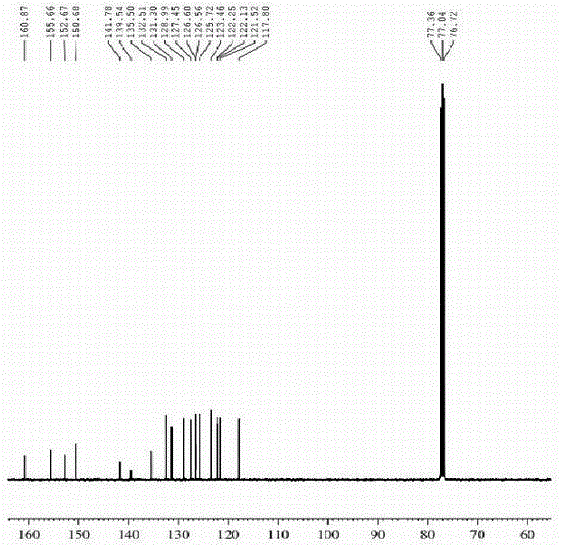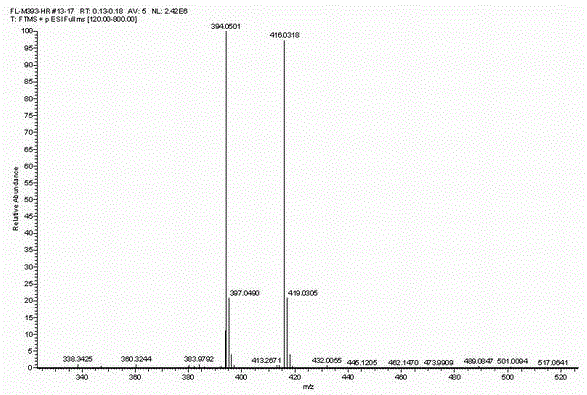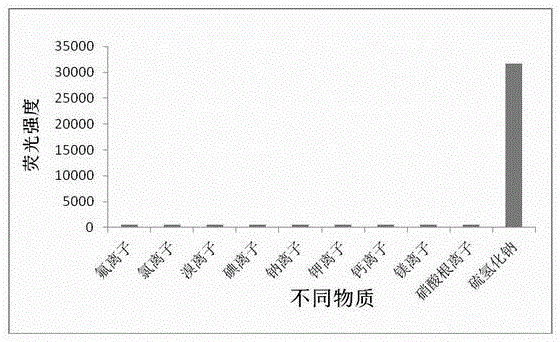A kind of fluorescent probe and its application of benzothiazole recognition hydrogen sulfide
A technology of benzothiazoles and fluorescent probes, applied in the field of fluorescent probes, can solve the problems of sample damage and failure to detect sulfides, achieve good fluorescence emission spectrum characteristics, simple synthesis process, and high sensitivity Effect
- Summary
- Abstract
- Description
- Claims
- Application Information
AI Technical Summary
Problems solved by technology
Method used
Image
Examples
Embodiment 12-(2
[0024] Chemical synthesis of embodiment 12-(2(2,4-dinitrophenoxy))benzothiazole
[0025]
[0026] (1) Dissolve 0.5mmol of 2-(2-hydroxyphenyl)benzothiazole, 0.625mmol of potassium carbonate and 0.5mmol of 2,4-dinitrobromobenzene in 10mL of acetonitrile, and react at 80°C for 4h;
[0027] (2) The reaction solution is subjected to vacuum distillation;
[0028] (3) The solid was purified by silica gel chromatography, and eluted with ethyl acetate-n-hexane (1:3v / v) to obtain a light yellow solid. For the characterization results, see figure 1 , figure 2 and image 3 . 1 HNMR(400MHz,DMSO)δ8.98(d,J=2.8Hz,1H),8.50(dd,J=7.9,1.6Hz,1H),8.42(dd,J=9.3,2.8Hz,1H),8.11( d,J=8.0Hz,1H),8.04(d,J=8.1Hz,1H),7.79–7.68(m,1H),7.66–7.51(m,2H),7.47(dd,J=14.4,7.5Hz ,2H),7.24(d,J=9.3Hz,1H).13CNMR(100MHz,CDCl3)δ160.87,155.66,152.67,150.68,141.78,139.54,135.50,132.51,131.30,128.99,127.45,126.657,125. 123.46, 122.25, 122.13, 121.52, 117.80. HRMScalcdforC16H14NO5+([M+H]+)394.0492,found394.0501.
Embodiment 22-(2
[0029] Example 22-(2(2,4-dinitrophenoxy))benzothiazole selectivity for different substances
[0030] (1) Prepare 99 μl metabolic reaction system in advance, including PBS buffer (10 mM) at pH 7.4: dimethyl sulfoxide (volume ratio 7:3), fluoride ion (100 μM), chloride ion (50 μM), bromide ion ( 100μM), iodide ion (100μM), sodium ion (100μM), potassium ion (100μM), calcium ion (100μM), magnesium ion (100μM), nitrate ion (100μM), sodium hydrosulfide (100μM);
[0031] (2) Add 1 μl of 2-(2(2,4-dinitrophenoxy))benzothiazole at a final concentration of 10 μM to the reaction system to initiate the reaction;
[0032] (3) After 30 minutes, perform fluorescence detection (λ Ex =300nm, λ Em =458nm); calculate the fluorescence intensity in each system (see Figure 4 ).
Embodiment 32-(2
[0033] Example 32-(2(2,4-dinitrophenoxy))benzothiazole and hydrogen sulfide concentration linear relationship
[0034] (1) Prepare 99μl metabolic reaction system in advance, including PBS buffer (10mM) at pH 7.4: dimethyl sulfoxide (volume ratio 7:3), hydrogen sulfide (0-100μM), react at 37°C for 30 minute;
[0035] (2) Add 1 μl of 2-(2(2,4-dinitrophenoxy))benzothiazole at a final concentration of 10 μM to the reaction system to initiate the reaction;
[0036] (3) After 30 minutes, perform fluorescence detection (λ Ex=300nm, λ Em =458nm); calculate the fluorescence intensity in each system, and establish the standard curve of fluorescence intensity and hydrogen sulfide concentration (see Figure 5 ); the standard curve is y=3695.9x-373.09, R2=0.9931, where y represents the fluorescence intensity at 458nm, and x represents the concentration of sodium hydrosulfide (the linear relationship between the concentration of hydrazine between 0uM and 100uM is satisfied).
PUM
 Login to View More
Login to View More Abstract
Description
Claims
Application Information
 Login to View More
Login to View More - R&D
- Intellectual Property
- Life Sciences
- Materials
- Tech Scout
- Unparalleled Data Quality
- Higher Quality Content
- 60% Fewer Hallucinations
Browse by: Latest US Patents, China's latest patents, Technical Efficacy Thesaurus, Application Domain, Technology Topic, Popular Technical Reports.
© 2025 PatSnap. All rights reserved.Legal|Privacy policy|Modern Slavery Act Transparency Statement|Sitemap|About US| Contact US: help@patsnap.com



